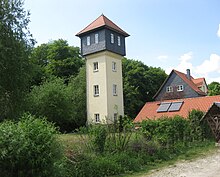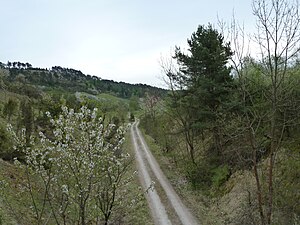Heiligenstadt – Schwebda railway line
| Heiligenstadt – Schwebda | |||||||||||||||||||||||||||||||||||||||||||||||||||||||||||||||||||||||||||||||||||||||||||||||||||||||||||||
|---|---|---|---|---|---|---|---|---|---|---|---|---|---|---|---|---|---|---|---|---|---|---|---|---|---|---|---|---|---|---|---|---|---|---|---|---|---|---|---|---|---|---|---|---|---|---|---|---|---|---|---|---|---|---|---|---|---|---|---|---|---|---|---|---|---|---|---|---|---|---|---|---|---|---|---|---|---|---|---|---|---|---|---|---|---|---|---|---|---|---|---|---|---|---|---|---|---|---|---|---|---|---|---|---|---|---|---|---|---|
|
Route of the railway line at Dieterode
| |||||||||||||||||||||||||||||||||||||||||||||||||||||||||||||||||||||||||||||||||||||||||||||||||||||||||||||
| Route number : | 6734 Heiligenstadt – Heiligenstadt Ost | ||||||||||||||||||||||||||||||||||||||||||||||||||||||||||||||||||||||||||||||||||||||||||||||||||||||||||||
| Course book section (DB) : | 201d (1944) | ||||||||||||||||||||||||||||||||||||||||||||||||||||||||||||||||||||||||||||||||||||||||||||||||||||||||||||
| Route length: | 32.1 km | ||||||||||||||||||||||||||||||||||||||||||||||||||||||||||||||||||||||||||||||||||||||||||||||||||||||||||||
| Gauge : | 1435 mm ( standard gauge ) | ||||||||||||||||||||||||||||||||||||||||||||||||||||||||||||||||||||||||||||||||||||||||||||||||||||||||||||
| Maximum slope : | 50 ‰ | ||||||||||||||||||||||||||||||||||||||||||||||||||||||||||||||||||||||||||||||||||||||||||||||||||||||||||||
| Rack system : | Dept | ||||||||||||||||||||||||||||||||||||||||||||||||||||||||||||||||||||||||||||||||||||||||||||||||||||||||||||
|
|||||||||||||||||||||||||||||||||||||||||||||||||||||||||||||||||||||||||||||||||||||||||||||||||||||||||||||

The Heiligenstadt – Schwebda railway line was laid out by the Prussian state as an access railway in the part of the Eichsfeld, which was still undeveloped from a traffic point of view.
In this area, which is enclosed by the Halle / Saale – Leinefelde – Heiligenstadt / Eichsfeld – Kassel , Leinefelde – Schwebda – Eschwege and Eichenberg – Eschwege routes , there was an urgent need to revive the economy. Around 1910, for example, the distribution of costs for building a branch line from Heiligenstadt / Eichsfeld via Kalteneber , Fürstenhagen , Dieterode , Krombach , Ershausen and Großtöpfer to Schwebda was debated. The Prussian state took over 251,000 marks, M 70,000 from the Eschwege district and M 311,000 from the Heiligenstadt district . The preparatory work could then begin.
history
Track construction and opening
In Heiligenstadt in Eichsfeld a site office was set up and the distance in seven building lots divided. Construction began in June 1911. The railway builders were faced with very difficult terrain. Since the distance between Heiligenstadt and Schwebda is only about 20 km, but the route was supposed to connect to the aforementioned places, it was extended to 32 km. In between there is a plateau at Kalteneber / Fürstenhagen at around 500 m above sea level. The climbs there are only possible from all sides in steep stream valleys or over equally steep slopes. The decision was therefore made to build a cogwheel train with three cogwheel sections according to the Abt system and accepted their disadvantages. The direct connection to the Reichsbahnnetz was advantageous as regular- gauge vehicles could be used on the steep route (no reloading from narrow-gauge to regular- gauge railway wagons or vice versa).
The disadvantage was the relatively low speed in the rack sections. Combined adhesion / rack-and-pinion locomotives with two independently operating engines from Borsig, similar to those on the Blankenburg-Tanne route in the Harz region, were used. They were equipped with compressed air brakes for the train and locomotive, the Riggenbach counter-pressure brake for the adhesion wheels and band brake for the gear drive, as well as a handbrake. Since the rack sections from the Pferdebachtal train station were up about 1.5 km before Kalteneber uphill and from Fürstenhagen to Dieterode and behind the train station to Krombach downhill, a hairpin was built in Fürstenhagen to save at least one change at the end of the train In the rack sections, the locomotive always had to stand by the train on the valley side. The line was the youngest of the regular-gauge adhesion / rack-and-pinion railways built under Prussian direction and the first whose operation was switched to pure friction drive.
The first section to Heiligenstadt-Dün (later Heiligenstadt Ost) went into operation on August 28, 1914. The rest of the route was opened on October 1, 1914.
Operation and adjustment
The costly cogwheel operation was given up in 1922 because the HBE (Halberstadt Blankenburg Railway) "Elch" locomotive proved that it was able to cope with inclines of over 6% in friction operation. After further tests, locomotives of the class pr.T 16.1 (later 94.5-17) were used. After the cogwheel operation had ceased, the locomotive only had to be relocated in Fürstenhagen, the steep sections were now driven through as normal. The operation from and to the confluence with the double-track cannon railway line Leinefelde-Schwebda was interesting. About 700 m before the Friedaviadukt, a junction with a small keeper's house was built, from which the points and signals were set. When the second track of the Kanonenbahn was dismantled after the First World War, the track to Schwebda from the junction to Schwebda station remained in operation for the Heiligenstadt railway line. Shortly before the end of the war, a special military train was parked in the Friedatunnel on the Heiligenstadt track and a switch connection to the Leinefeld track was installed in front of the tunnel. On April 2, 1945, the viaduct over the Frieda was blown up by retreating Wehrmacht units and operations were interrupted. The bridge was no longer built because it was in the border area between Hesse and Thuringia, i.e. the border between the American and Soviet-occupied zones. The section between Heiligenstadt Ost and Großtöpfer was used until the summer of 1947, after which it was shut down and quickly dismantled. On the German side, the Friedatunnel in front of the Friedabrücke was used by the Federal Railway Central Office in Minden as a climate chamber and was accessible by rail. Today the tunnel is closed.
The first section between Heiligenstadt and Heiligenstadt Ost was operated in freight traffic until December 31, 1994, most recently as a main line of the Heiligenstadt station. At the moment, parts of the track system are still used by Heiligenstadt railway enthusiasts.
Route
The line began in Heiligenstadt (Eichsfeld) (km 0.0–248 m above sea level) in the train station on the Halle-Kassel line on a separate platform east of the reception building. Until the reconstruction a few years ago you could still see the platform. At the eastern signal box is also the shed in which a locomotive was stationed, the other two mainline locomotives were located in Eschwege Niederhone (West). The next 1.5 km led the line as a third track towards Leinefelde , and then to the south to pan. After another kilometer, you reached the Heiligenstadt (Eichsfeld) -Ost train station (km 2.6–268 m). There were several loading tracks, two platform tracks and the train conductor who was (exclusively) responsible for train operations as far as Ershausen. Always ascending in the valley of the Geislede and the Pferdebach, the route ran at the edge of the forest at the paper mill (with siding) to the Pferdebachtal train station, where there was an intersection and a loading platform on both sides. Here the cogwheel locomotives had to switch to the other side of the train when it was going uphill. A 600 m long siding to the WIFO fuel storage facility branched off horizontally from the loading track in the direction of Heiligenstadt. Fuels were delivered, stored, remixed and re-dispatched on two dead ends. A Wehrmacht diesel locomotive took over the shunting service. The first rack section (km 6.5-8.1), which led the railway to the plateau in front of Kalteneber, began 200 m behind Pferdebachtal. Almost at ground level, we continued over fields to Fürstenhagen. Here the steam locomotives could replenish their water supply, the 94.5 had to move over a bypass track, a loading track with ramp and the water tower at the station building were part of the equipment. After Dieterode straight ahead, the railway led into the second rack section (km 14.7-16.1) in the horizontally laid out Dieterode train station with reloading and loading track. Directly behind the train station was the third rack section (km 16.6-18.1), which brought the railway below the Dieteröder cliffs to Krombach. Here, too, there was a reloading track: on a high embankment and in a semicircle behind the locality of Krombach, the route turned to the east and it went in a stream valley to Ershausen, the largest intermediate station next to Heiligenstadt Ost with a water crane, reloading and loading track and the headquarters of the railway foremen's own office Building a little below the train station towards Großtöpfer. Up to this point, shuttle trains also ran once a day from Eschwege, sometimes even with the "bG" symbol in the timetable, which could indicate the use of multiple units. The dispatcher for the Ershausen-Schwebda section also sat here. Driving further downhill in the valley of the Rosoppe, Großtöpfer was reached. From mid-1945-1947 the terminus was here. Linkerhand about 30 m higher and about two kilometers away the Geismar cannon train approached our route falling, and then on the last two kilometers a little Distance further falling next to the Heiligenstädter Bahn. At what would later become the FRG / GDR border, the two railways crossed a forest path almost next to each other, but with a difference in altitude of a good 10 m. Further 300 m downhill, you pass a small brick building, the former signal box of the junction. You can still find the short stump track as a safety track at the confluence with the Leinefelder / Geismar route on the course of the embankments in the forest. On a high embankment in a slight right curve, the route leads to the former Friedaviadukt and then into the Friedatunnel. After passing through it, it went three-track to Schwebda station, since the track on the Wartha-Eschwege line also led into the station on the far left.
literature
- Paul Lauerwald: The »Bimmelbähnchen« - On the history of the Heiligenstadt – Schwebda railway line . Self-published, 1984.
- Paul Lauerwald: Railways in the Eichsfeld. Eichsfeld railway stories up to the present . Mecke Druck und Verlag, 1994, ISBN 3-923453-56-6 .
- Paul Lauerwald: Heiligenstadt (Eichsfeld) - Fürstenhagen (Eichsfeld) - Schwebda (- Eschwege) . In: Secondary and narrow-gauge railways in Germany then & now. 97th supplementary edition , Gera Mond Munich 2012, ISSN 0949-2143 .
- Paul Lauerwald: 100 years ago the branch line Heiligenstadt (Eichsfeld) - Fürstenhagen (Eichsfeld) - Schwebda (- Eschwege) was opened. In: Eichsfelder Heimatzeitschrift 58, 2014, issue 7/8, July / August 2014, pp. 253-257. Duderstadt 2014. ISSN 1611-1648 .
- Schwarzbach, Winfried. Own research
